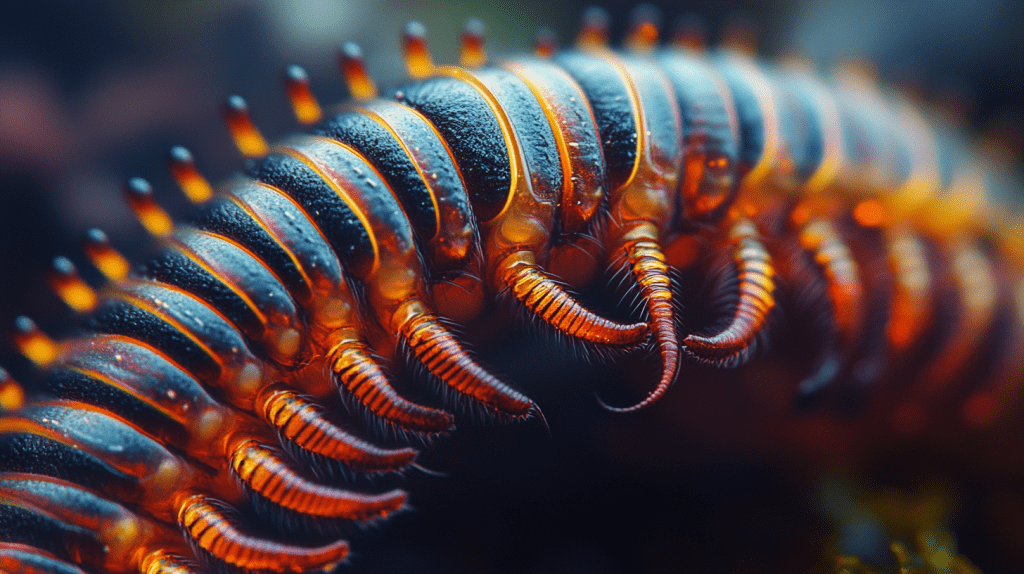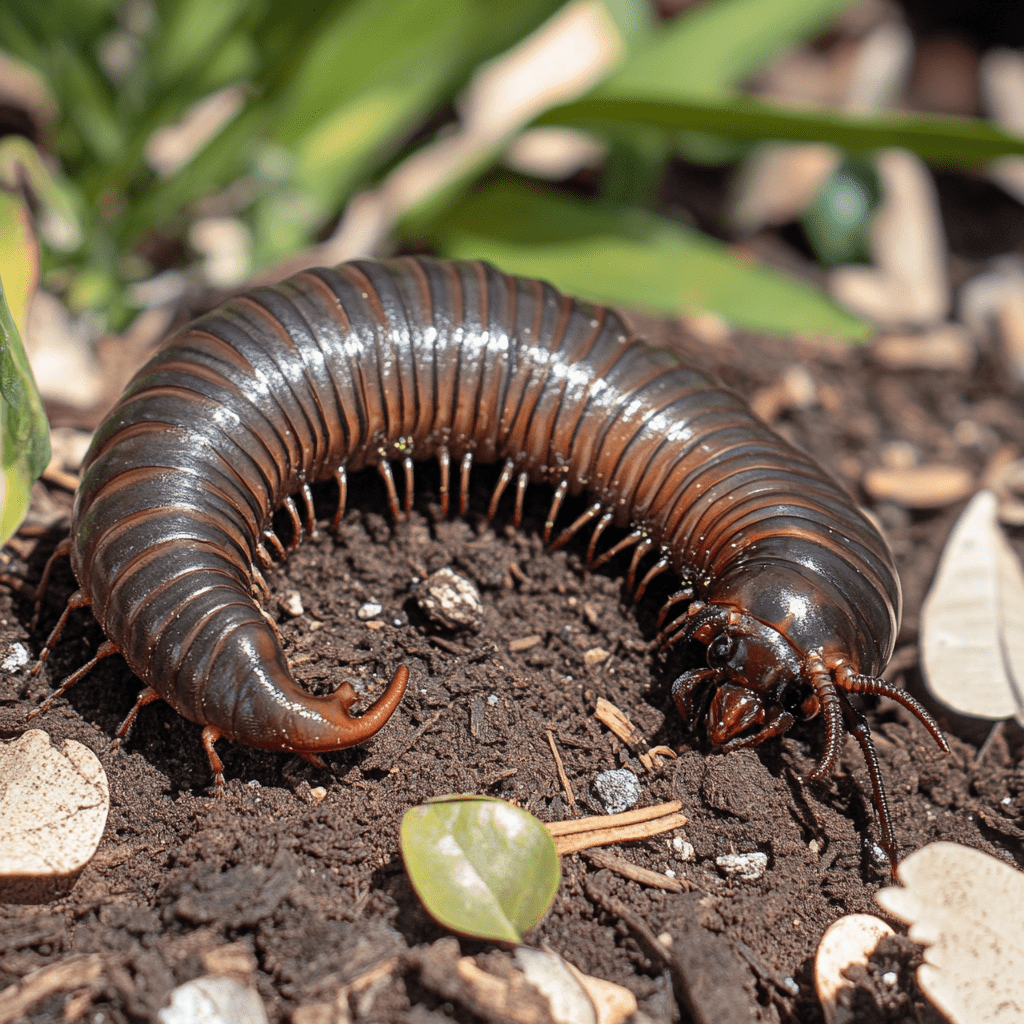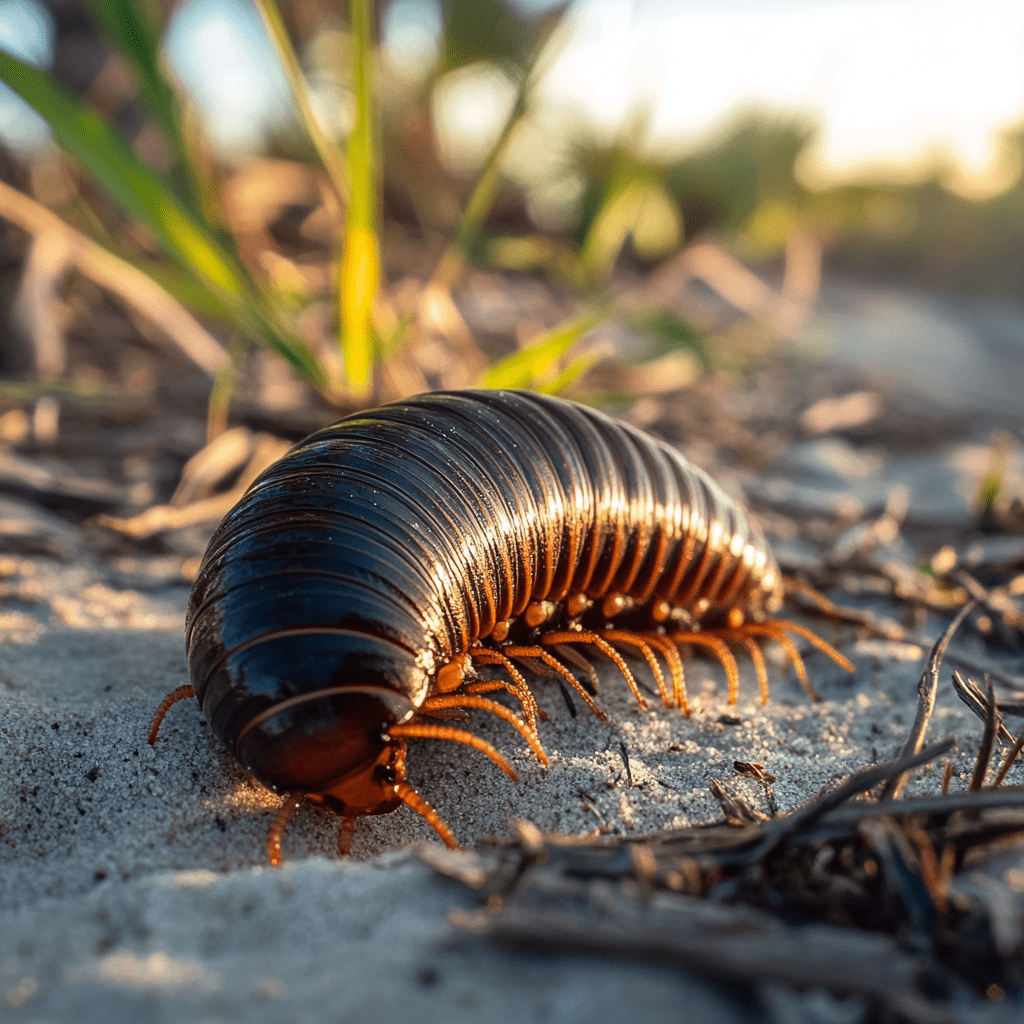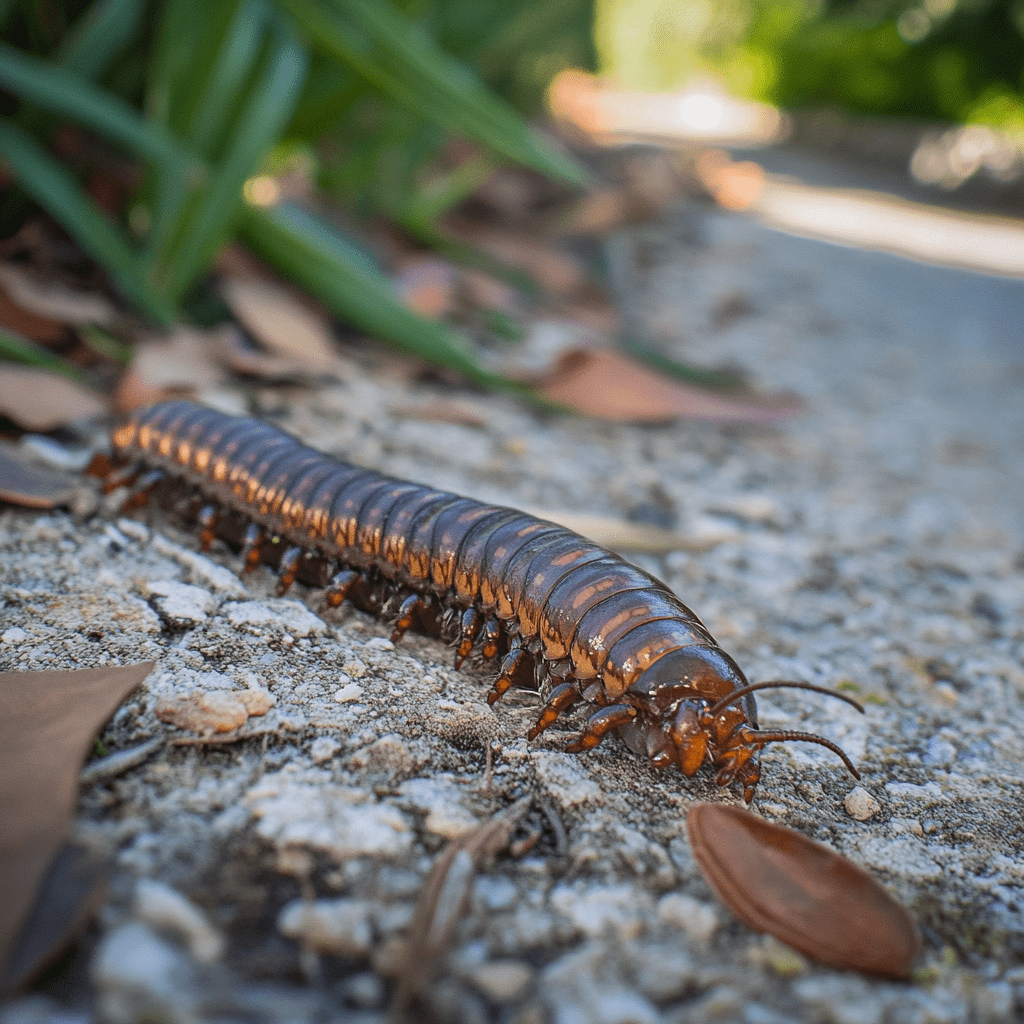
Table of Contents
Millipedes are fascinating yet unwelcome guests in many Bradenton, FL homes. While these multi-legged creatures play an essential role in breaking down organic matter in the wild, they can quickly become a nuisance indoors. If you’ve ever seen a millipede slowly crawling across your floor or found one in your basement, you’re not alone—these moisture-loving insects are drawn to Florida’s humid climate.
To get rid of millipedes, it’s important to first understand their habits and behavior. Millipedes don’t actually have 1,000 legs, as their name suggests. Most species have between 30 and 400 legs, and they tend to move slowly, which allows them to conserve energy while feeding on decaying plant matter. Interestingly, they’ve been on Earth for over 400 million years, making them one of the oldest known land animals! While millipedes are generally harmless to humans, some species can secrete a mild toxin that can irritate your skin if handled.
These creatures are drawn to damp, dark environments, and in Bradenton, where humidity is high year-round, millipedes are often found in basements, bathrooms, and under organic debris in gardens. They thrive in moist conditions but can become a problem when they invade homes in search of shelter. Getting rid of millipedes is not only about eliminating the pests you see but also about addressing the environmental factors that attract them, like moisture and organic debris.
In this blog post, we’ll explore the most effective ways to get rid of millipedes, both inside and outside your home, using expert tips and natural remedies. Whether you’re dealing with a small infestation or want to prevent these critters from entering your house in the first place, understanding their behavior and implementing the right strategies will help you reclaim your space. Keep reading to learn more about millipede control and how to protect your home in Bradenton from these persistent pests.
Key Takeaways
- Millipedes Thrive in Moisture: These arthropods are drawn to damp environments like basements, bathrooms, and crawl spaces. Reducing moisture in and around your home is essential for millipede control.
- Harmless but Unwelcome Guests: While millipedes are not dangerous to humans or pets, they can become a nuisance when they invade homes in large numbers, especially after heavy rains.
- Natural Remedies Are Effective: Diatomaceous earth, essential oils, vinegar sprays, and boric acid are natural solutions to repel and eliminate millipedes without using harsh chemicals.
- Prevention Is Key: Regularly sealing cracks and gaps, managing moisture, and removing organic debris from around your home’s perimeter will help prevent future millipede infestations.
- Professional Solutions for Persistent Issues: For larger infestations, professional pest control services use targeted chemical treatments, such as pyrethroid-based insecticides, and offer ongoing maintenance to ensure long-term millipede control.
By focusing on moisture control, exclusion methods, and natural or professional treatments, you can successfully get rid of millipedes and keep your Bradenton home pest-free.
Common Millipedes Found in Florida – Identification Guide
Florida is home to a variety of millipede species, each with distinct characteristics that contribute to the local ecosystem. These arthropods play an important role in breaking down organic matter, helping to recycle nutrients back into the soil. One of the most common species is the Greenhouse Millipede (Oxidus gracilis), a small millipede often found in gardens and greenhouses. This species is beneficial for aerating soil and aiding in decomposition. The Florida Ivory Millipede (Chicobolus spinigerus), a larger species reaching up to 3.5 inches in length, is known for secreting a noxious substance as a defense mechanism. Its solid-dark body and lighter underbelly make it easily recognizable. Another striking species is the Yellow-Banded Millipede (Anadenobolus monilicornis), which features yellow bands around a dark body. While commonly found in South Florida, it can cause mild skin irritation if crushed.
Common Millipede Species in Florida
1. Greenhouse Millipede (Oxidus gracilis)
Found frequently in gardens and greenhouses, these millipedes are small, typically under an inch in length. They play a role in soil aeration and decomposition, benefiting plant life.
2. Florida Ivory Millipede (Chicobolus spinigerus)
These larger millipedes, reaching up to 3.5 inches, have a dark, solid body with lighter-colored legs and belly. They are known for their defensive secretion, which can be unpleasant to predators.
3. Yellow-Banded Millipede (Anadenobolus monilicornis)
This species, marked by bright yellow bands around a dark body, is commonly found in South Florida. They can cause minor skin irritation if crushed.
4. North American Millipede (Narceus americanus)
Also called the “rust” or “iron” millipede, these dark-brown millipedes with reddish stripes are large and commonly seen across Florida.
5. Florida Megaphyllum Millipede (Narceus gordanus)
Distinguished by its black body with striking yellow bands, this species is known for its bold appearance.
6. Red Rusty Millipede (Trigoniulus corallinus)
This species is less likely to invade homes but is commonly found in damp, shaded outdoor areas where it feeds on decaying plant material.
Although they may sometimes be unwelcome when they wander indoors, millipedes are crucial to the environment. Their role in decomposing organic matter helps recycle nutrients back into the soil, promoting healthy ecosystems.
The North American Millipede (Narceus americanus), also known as the “rust” or “iron” millipede, is widely distributed across the state. Its dark-brown body with deep-red stripes and large size make it a frequent sight in gardens. Similarly, the Florida Megaphyllum Millipede (Narceus gordanus) stands out with its black body and vibrant yellow bands, adding to its striking appearance. Finally, the Red Rusty Millipede (Trigoniulus corallinus) is less common indoors but thrives in moist, shady outdoor environments where it feeds on decaying plant matter. Although these millipedes can sometimes become a nuisance when they enter homes, they are generally harmless and serve as vital decomposers in Florida’s ecosystems.
Millipede Identification In Bradenton, FL

Millipedes are unique arthropods that belong to the class Diplopoda, often recognized by their elongated bodies and numerous legs. Unlike the fast and predatory centipedes, millipedes are slow-moving creatures that spend their time foraging for decaying organic material. Ranging in size from 2 to 4 centimeters, some species of millipedes can grow much larger, especially in tropical regions. They are typically dark-colored, such as brown or black, but certain species showcase more vibrant hues, serving as a warning to predators about their chemical defenses.
What sets millipedes apart from other arthropods is their segmented bodies, with two pairs of legs per segment. Depending on the species, a single millipede may have anywhere between 34 and over 400 legs. Their slow, deliberate movements are the result of the wave-like coordination of their many legs. Rather than being hunters, like centipedes, millipedes are primarily detritivores, feeding on decaying plant matter, leaves, and occasionally fungi. This diet makes them important contributors to soil health, as they help break down organic material and recycle nutrients into the ecosystem.
Millipede Identification

Physical Characteristics
- Body Structure: Millipedes have long, cylindrical or slightly flattened bodies composed of many segments.
- Legs: Two pairs of legs per body segment, except for the first few segments. The number of legs can range from 34 to over 400, depending on the species.
- Size: Most millipedes range from 2 to 4 cm in length, although some tropical species can grow much larger.
- Color: Generally black or brown, but some species are brightly colored and may exhibit aposematic coloring to warn predators of their toxicity.
Distinguishing Features
- Movement: Millipedes move in a slow, wave-like motion due to their numerous legs.
- Defense Mechanism: When threatened, they curl into a tight coil to protect their softer underside. Some species can secrete a foul-smelling liquid as a defense.
- Antennae: Short and elbowed, used for probing their environment.
Habitat and Behavior
- Habitat: Prefer moist environments such as forest floors, under rocks, leaf litter, and decaying wood. They thrive in humid conditions.
- Diet: Primarily detritivores, feeding on decaying organic matter like leaves and wood. Some species may also consume fungi.
Differences from Centipedes
- Legs: Millipedes have two pairs of legs per segment, while centipedes have one pair per segment.
- Movement: Millipedes are slower and adapted for burrowing, while centipedes are faster and adapted for running.
- Venom: Millipedes do not have venomous fangs, instead relying on chemical defenses.
Millipedes play an important ecological role as decomposers. They are generally harmless to humans but can become a nuisance if they invade homes in search of moisture. Identification often involves observing their physical characteristics and behavior in their natural habitat.
Millipedes prefer environments with high moisture levels, such as the forest floor, under rocks, in leaf litter, or within decaying wood. Their bodies are not well-suited for dry conditions, which is why they are often found in humid climates or during rainy seasons. In places like Sarasota, FL, millipedes thrive due to the moisture-rich environment, but this also increases the likelihood of them invading homes during wet weather. They seek out basements, crawl spaces, and other damp areas inside homes where they can find refuge.
One of the millipede’s most interesting defense mechanisms is their ability to secrete a foul-smelling or toxic fluid from glands located along their bodies. This secretion helps deter predators, but despite this defense, millipedes remain harmless to humans. They cannot bite or sting, and their slow, rolling movements are meant more to avoid harm than to attack. When disturbed, millipedes often curl into a tight coil to protect their vulnerable undersides, a behavior that distinguishes them from their faster, more aggressive centipede relatives.
Though they share some similarities with centipedes, there are clear differences between the two. Millipedes have two pairs of legs per body segment, whereas centipedes have only one. Additionally, millipedes are much slower and rely on chemical defenses, while centipedes are built for speed and use venomous fangs to subdue their prey. Millipedes are adapted for burrowing and living in moist, dark environments, while centipedes prefer to hunt in open spaces and move quickly to capture their food.
While millipedes are not a threat to homes or health, they can become a nuisance when they enter living spaces in large numbers, especially after periods of heavy rain. Homeowners in Sarasota may find millipedes congregating in areas like bathrooms, basements, or near doorways, seeking moisture. To get rid of millipedes, it’s essential to reduce excess moisture, seal entry points, and remove organic material from around the home to prevent them from entering.

Effective Millipede Control in Bradenton!
Take control of your home today! Contact Bradenton Pest Control at (941) 326-5011 for expert pest management. Proudly serving Bradenton, FL, we keep your home tick-free all year round.
Get StartedUnderstanding millipedes, from their physical characteristics to their behavior and habitat preferences, is key to managing and identifying these creatures both in their natural environments and when they venture indoors. While they are beneficial in their role as decomposers in nature, millipedes can quickly become unwelcome houseguests if moisture problems persist inside your home.
Get Rid Of Millipedes Naturally In Bradenton, FL

If you’re dealing with millipedes in your home, there are several natural methods to manage and eliminate them without using chemical-based treatments. One option is diatomaceous earth (DE), which can be sprinkled around the areas where millipedes are active. This natural powder is highly effective as it dehydrates millipedes when they come into contact with it. Boric acid works similarly, damaging the exoskeleton of millipedes and causing dehydration, making it a useful alternative.
Essential oils such as peppermint or tea tree oil can also be used as natural deterrents. You can mix a few drops with water and spray the mixture around your home’s entry points. Another easy home remedy is a vinegar spray—simply combine one part vinegar with four parts water and a little dish soap to create a solution that helps disrupt millipede activity.
Natural Ways to Control Millipedes
- Diatomaceous Earth (DE): Sprinkle food-grade diatomaceous earth around areas where millipedes appear. This powder causes dehydration and eliminates them upon contact.
- Boric Acid: Similar to DE, boric acid works by damaging the millipede’s outer shell, causing it to dry out and die. Sprinkle it in problem areas to help reduce their numbers.
- Essential Oil Spray: Combine peppermint or tea tree oil with water and spray it around doorways, windows, and cracks. These oils naturally repel millipedes and other pests.
- Vinegar and Soap Mixture: Create a spray using vinegar, water, and a touch of dish soap. Use it in areas where millipedes are entering your home to disrupt their movement and keep them away.
- Neem Oil Treatment: Apply neem oil along common entry points like windows or doors. Its natural compounds discourage millipedes from entering your home.
- Cayenne Pepper: Sprinkle cayenne pepper in places where you notice millipedes congregating. The spicy scent acts as a strong deterrent.
- Garlic-Based Spray: Mix crushed garlic with water and let it steep overnight. Strain the mixture and spray it in areas where millipedes are frequently seen to repel them.
- Manual Cleanup: For minor infestations, you can sweep up millipedes and dispose of them outside, preventing them from becoming a larger issue.
- Moisture Control: Reduce dampness in your home by using dehumidifiers and fixing any leaks. Millipedes thrive in moisture-rich environments, so keeping things dry can help reduce their presence.
- Seal Gaps: Check for and seal any cracks, gaps, or openings around doors, windows, and foundations to prevent millipedes from entering your home in the first place.
For those looking to target millipedes specifically at entry points, neem oil is another natural option. This plant-based oil contains compounds that repel millipedes effectively. Alternatively, cayenne pepper and garlic spray can be used to deter millipedes, with their strong odors acting as natural repellents. Simply sprinkle cayenne pepper or spray the garlic solution in areas where millipedes tend to gather.
If you prefer a more hands-on approach, manual removal is always an option for smaller infestations. Removing millipedes with a broom or vacuum and releasing them outdoors can be an immediate fix. However, for long-term results, it’s important to reduce moisture levels in and around your home, as millipedes thrive in damp environments. Dehumidifiers, fixing leaks, and eliminating standing water can help make your home less appealing to them.
Finally, to prevent future infestations, ensure that you seal off entry points by inspecting for cracks and gaps around doors, windows, and foundations. Closing off these entryways will help keep millipedes from returning.
By combining these natural methods and maintaining a well-sealed and dry environment, you can effectively get rid of millipedes and keep your home pest-free.
Get Rid Of Millipedes Professionally In Bradenton, FL

Professional approaches to getting rid of millipedes involve a strategic combination of chemical treatments and long-term prevention efforts. One common method is the use of pyrethroid-based insecticides, such as bifenthrin, cyfluthrin, and lambda-cyhalothrin. These chemicals are highly effective when applied around the exterior of a home, focusing on the foundation and potential entry points. For outdoor areas like gardens or lawns, granular insecticides are often preferred as they cover larger areas and work well in environments where millipedes thrive.
For quick and direct control inside the home, pyrethrin-based contact sprays are highly effective. These sprays can be applied directly to millipedes and used in high-traffic areas like cracks, crevices, or along baseboards. This method provides immediate results for millipedes that have already made their way indoors.
An Integrated Pest Management (IPM) approach provides a more sustainable solution by addressing both immediate infestations and long-term prevention. This process begins with a thorough inspection to identify how millipedes are entering the home. Once entry points are identified, exclusion techniques such as sealing gaps, cracks, and crevices around windows, doors, and the foundation can keep future millipedes out.
Professional Millipede Control Methods
Chemical Control Methods
- Insecticides: Use pyrethroid-based insecticides like bifenthrin, cyfluthrin, cypermethrin, or lambda-cyhalothrin. Apply these around the foundation and entry points. Granular insecticides work well for outdoor areas like turf and gardens.
- Contact Sprays: Quick-acting pyrethrin-based sprays are ideal for immediate control of indoor millipedes. Spray directly on millipedes and target cracks, crevices, and baseboards where they tend to hide.
Integrated Pest Management (IPM)
- Inspection and Identification: Conduct thorough inspections to find entry points and nesting areas within the home.
- Exclusion: Seal gaps, cracks, and crevices around doors, windows, and foundations to block millipedes from entering.
- Moisture Control: Fix leaks, use dehumidifiers, and ensure proper drainage to reduce moisture around the home—this is key to preventing millipede infestations.
- Habitat Modification: Clear away organic matter like mulch, leaves, and grass clippings from around your home’s foundation to eliminate potential habitats for millipedes.
Professional Pest Control Services
Engaging a professional pest control service offers a comprehensive approach, combining chemical and non-chemical treatments. Experts ensure effective application and address all entry points and habitats. This approach helps provide long-term protection from millipedes.
Ongoing Monitoring and Maintenance
- Regularly inspect treated areas for recurring millipede activity.
- Continue preventive measures like sealing gaps and managing moisture levels to stop future infestations.
Moisture management is another key aspect of IPM. Millipedes are highly attracted to moist environments, so reducing humidity levels indoors is critical. This can be done by fixing leaks, improving ventilation, and using dehumidifiers. Additionally, removing organic material like leaf litter, mulch, and wood piles from the yard will help reduce their outdoor habitats.
Professional pest control services offer an advanced and thorough solution, as experts can apply more potent chemicals safely and with precision. They also provide tailored advice and can address both current infestations and potential future problems through preventative treatments. Regular follow-up treatments, such as quarterly visits, ensure long-term control and prevent reinfestation.
Ultimately, the most successful approach involves a blend of chemical treatments, exclusion techniques, moisture control, and professional pest management to achieve lasting results against millipedes.
Frequently Asked Questions (FAQs)
What are millipedes, and why are they entering my home in Bradenton, FL?
Millipedes are moisture-loving arthropods with long, segmented bodies and numerous legs. They typically feed on decaying plant matter and thrive in damp environments. In Florida, especially in humid climates like Bradenton, millipedes often enter homes seeking moisture and shelter, particularly during or after rainy seasons.
Are millipedes harmful to humans or pets?
No, millipedes are generally harmless to humans and pets. They do not bite or sting, but some species may secrete a foul-smelling liquid when threatened, which can cause mild irritation if touched. While they can be a nuisance indoors, they do not pose significant health risks.
What are some natural ways to get rid of millipedes?
There are several effective natural methods to get rid of millipedes:
- Diatomaceous Earth (DE): Sprinkle food-grade DE around entry points to dehydrate millipedes upon contact.
- Essential Oils: Use tea tree or peppermint oil mixed with water and spray around doors and windows to repel millipedes.
- Vinegar Spray: A mixture of vinegar and water can disrupt millipede movement when sprayed around the home.
- Manual Removal: Sweeping up millipedes and releasing them outside can be an immediate fix for smaller infestations.
How do I prevent millipedes from entering my home?
To prevent millipedes from entering, focus on reducing moisture levels inside your home. Use dehumidifiers, fix leaks, and remove standing water. Additionally, sealing cracks and gaps around windows, doors, and foundations can help keep them out. Maintaining a clean yard by removing organic debris like mulch, leaves, and wood piles will also reduce millipede habitats near your home.
Why do I keep seeing millipedes in my bathroom and basement?
Bathrooms, basements, and other areas with high moisture are attractive to millipedes because they thrive in damp environments. These areas tend to provide the moisture and shelter they seek, especially in a humid region like Bradenton. Addressing moisture control by improving ventilation and fixing leaks can help reduce millipede activity in these spaces.
Do millipedes cause damage to my home or belongings?
Millipedes do not cause any structural damage to homes or belongings. They primarily feed on decaying organic matter like leaves and wood, and while they can become a nuisance if they enter your home in large numbers, they do not harm furniture, walls, or personal items.
What professional methods are available to get rid of millipedes?
Professional methods for getting rid of millipedes involve using pyrethroid-based insecticides around the home’s foundation and entry points. For outdoor control, granular insecticides are effective in treating lawns and garden areas. Professional pest control services also offer Integrated Pest Management (IPM) strategies that combine chemical treatments with exclusion, moisture control, and habitat modification for long-term prevention.
How does moisture control help in millipede prevention?
Millipedes are highly attracted to moist environments. By reducing moisture levels inside and around your home—through fixing leaks, using dehumidifiers, and improving ventilation—you can make your home less appealing to millipedes. Proper drainage and removing standing water around the exterior will also help prevent infestations.
Can essential oils really help repel millipedes?
Yes, essential oils such as peppermint and tea tree oil have natural repellent properties that can deter millipedes. When mixed with water and sprayed around entry points like windowsills, door gaps, and foundation cracks, these oils can help keep millipedes from entering your home.
When should I consider professional pest control for millipedes?
If you’re dealing with a persistent or large-scale infestation that natural methods aren’t addressing, it may be time to contact professional pest control services. Professionals can apply stronger, more effective treatments and provide long-term solutions by addressing both the current infestation and preventing future issues through follow-up treatments and exclusion techniques.
By understanding millipedes’ behavior and implementing a combination of natural and professional methods, you can effectively keep them out of your Bradenton home and maintain a pest-free environment.









